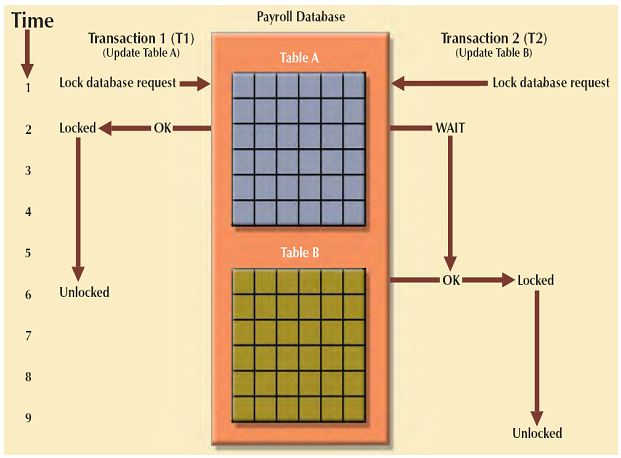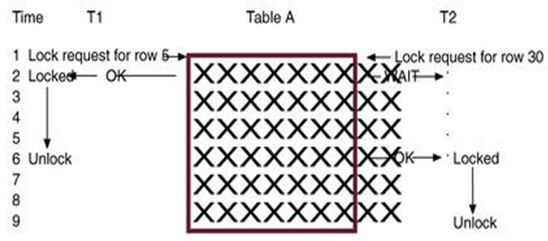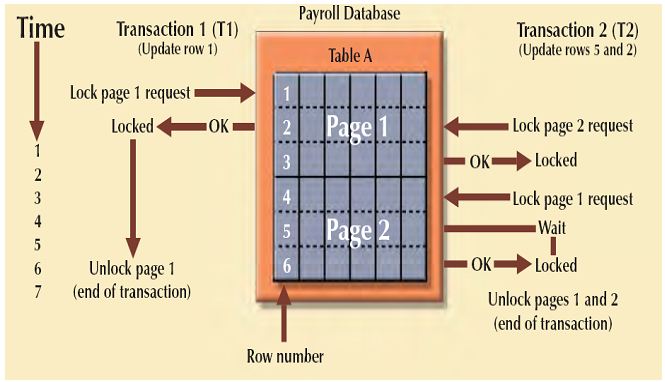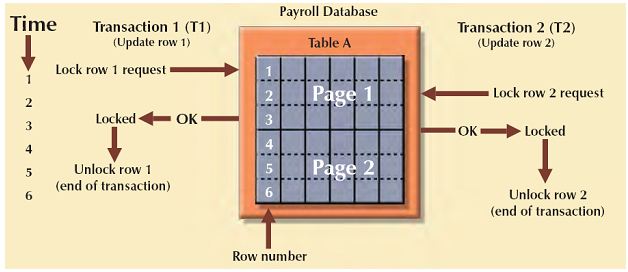Concurrency Control With Locking Methods
A lock guarantees exclusive use of a data item to a current transaction. In other words, transaction T2 does not have access to a data item that is currently being used by transaction T1.
A transaction acquires a lock prior to data access; the lock is released (unlocked) when the transaction is completed so that another transaction can lock the data item for its exclusive use. This series of locking actions assumes that there is a likelihood of concurrent transactions attempting to manipulate the same data item at the same time. The use of locks based on the assumption that conflict between transactions is likely to occur is often referred to as pessimistic locking.
The data consistency cannot be guaranteed during a transaction; the database might be in a temporary inconsistent state when several updates are executed. Therefore, locks are required to prevent another transaction from reading inconsistent data. Most multiuser DBMSs automatically initiate and enforce locking procedures. All lock information is managed by a lock manager, which is responsible for assigning and policing the locks used by the transactions.
Lock Granularity:
Lock granularity indicates the level of lock use. Locking can take place at the following levels: database, table, page, row, or even field (attribute).
You May Also Like:
Transaction and Its Properties
Concurrency Problems
Concurrency Control with Locking
Database Level
In a database-level lock, the entire database is locked, thus preventing the use of any tables in the database by transaction T2 while transaction Tl is being executed. This level of locking is good for batch processes, but it is unsuitable for multiuser DBMSs. You can imagine how s-l-o-w the data access would be if thousands of transactions had to wait for the previous transaction to be completed before the next one could reserve the entire database.
The above figure illustrates the database-level lock. Note that because of the database-level lock, transactions T1 and T2 cannot access the same database concurrently even when they use different tables.
Table Level:
In a table-level lock, the entire table is locked, preventing access to any row by transaction T2 while transaction T1 is using the table. If a transaction requires access to several tables, each table may be locked. However, two transactions can access the same database as long as they access different tables.
Table-level locks, while less restrictive than database-level locks, because traffic jams when many transactions are waiting to access the same table. Such a condition is especially irksome if the lock forces a delay when different transactions require access to different parts of the same table, that is, when the transactions would not interfere with each other. Consequently, table-level locks are not suitable for multiuser DBMSs.
Page Level:
In a page-level lock, the DBMS will lock an entire disk page. A disk page, or page, is the equivalent of a disk block, which can be described as a directly addressable section of a disk. A page has a fixed size, such as 4K, 8K, or 16K. For example, if you want to write only 73 bytes to a 4K page, the entire 4K page must be read from disk, updated in memory, and written back to disk. A table can span several pages, and a page can contain several rows of one or more tables. Page-level locks are currently the most frequently used multiuser DBMS locking method. Note that T1 and T2 access the same table while locking different diskpages. If T2 requires the use of a row located on a page that is locked by T1, T2 must wait until the page is unlocked by T1.
Row Level:
A row-level lock is much less restrictive than the locks discussed earlier. The DBMS allows concurrent transactions to access different rows of the same table even when the rows are located on the same page. Although the row- level locking approach improves the availability of data, its management requires high overhead because a lock exists for each row in a table of the database involved in a conflicting transaction. Modern DBMSs automatically escalate a lock from a row-level to a page-level lock when the application session requests multiple locks on the same page.
The following figure explains the Row level lock.
In the above figure both transactions can execute concurrently, even when the requested rows are on the same page. T2 must wait only if it requests the same row as T1.
Field Level:
The field-level lock allows concurrent transactions to access the same row as long as they require the use of different fields (attributes) within that row. Although field-level locking clearly yields the most flexible multiuser data access, it is rarely implemented in a DBMS because it requires an extremely high level of computer overhead and because the row-level lock is much more useful in practice.
Binary Locks
A binary lock has only two states: locked (1) or unlocked (0). If an object—that is, a database, table, page, or row—is locked by a transaction, no other transaction can use that object. If an object is unlocked, any transaction can lock the object for its use. Every database operation requires that the affected object be locked. As a rule, a transaction must unlock the object after its termination. Therefore, every transaction requires a lock and unlock operation for each data item that is accessed. Such operations are automatically managed and scheduled by the DBMS; the user does not need to be concerned about locking or unlocking data items. (Every DBMS has a default locking mechanism. If the end user wants to override the default, the LOCK TABLE and other SQL commands are available for that purpose.)
The binary locking technique is illustrated in the following table, using the lost updates problem. Note that the lock and unlock features eliminate the lost update problem because the lock is not released until the WRITE statement is completed. Therefore, a PROD_QOH value cannot be used until it has been properly updated.
However, binary locks are now considered too restrictive to yield optimal concurrency conditions. For example, the DBMS will not allow two transactions to read the same database object even though neither transaction updates the database, and therefore, no concurrency problems can occur. The concurrency conflicts occur only when two transactions execute concurrently and one of them updates the database

Shared/Exclusive Locks:
The labels “shared” and “exclusive” indicate the nature of the lock. An exclusive lock exists when access is reserved specifically for the transaction that locked the object. The exclusive lock must be used when the potential for conflict exists. A shared lock exists when concurrent transactions are granted read access on the basis of a common lock. A shared lock produces no conflict as long as all the concurrent transactions are read-only. A shared lock is issued when a transaction wants to read data from the database and no exclusive lock is held on that data item. An exclusive lock is issued when a transaction wants to update (write) a data item and no locks are currently held on that data item by any other transaction. Using the shared/exclusive locking concept, a lock can have three states: unlocked, shared (read), and exclusive (write).
As shown in the above table, two transactions conflict only when at least one of them is a Write transaction. Because the two Read transactions can be safely executed at once, shared locks allow several Read transactions to read the same data item concurrently.
For example, if transaction T1 has a shared lock on data item X and transaction T2 wants to read data item X, T2 may also obtain a shared lock on data item X.
If transaction T2 updates data item X, an exclusive lock is required by T2 over data item X. The exclusive lock is granted if and only if no other locks are held on the data item. Therefore, if a shared or exclusive lock is already held on data item X by transaction T1, an exclusive lock cannot be granted to transaction T2 and T2 must wait to begin until T1 commits. This condition is known as the mutual exclusive rule: only one transaction at a time can own an exclusive lock on the same object. Although the use of shared locks renders data access more efficient, a shared/exclusive lock schema increases the lock manager’s overhead, for several reasons:
• The type of lock held must be known before a lock can be granted.
• Three lock operations exist: READ_LOCK (to check the type of lock), WRITE_LOCK (to issue the lock), and UNLOCK (to release the lock).
• The schema has been enhanced to allow a lock upgrade (from shared to exclusive) and a lock downgrade (from exclusive to shared).
Although locks prevent serious data inconsistencies, they can lead to two major problems:
• The resulting transaction schedule might not be serializable.
• The schedule might create deadlocks. A deadlock occurs when two transactions wait indefinitely for each other to unlock data. A database deadlock, which is equivalent to traffic gridlock in a big city, is caused when two or more transactions wait for each other to unlock data.
Concurrency Control With Time Stamping
Concurrency Control With Optimistic Method





